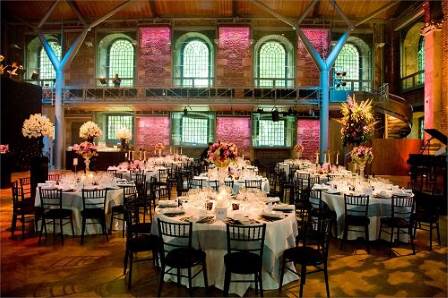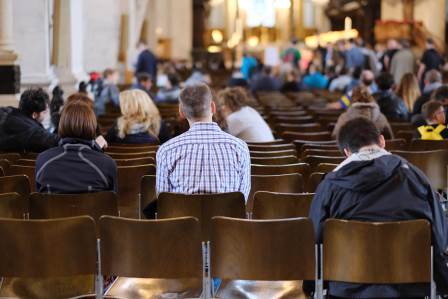Is Britain still a Christian country? A 2012 opinion poll by YouGov suggested that a majority (56 per cent) believe that it is. But this is not reflected in our churchgoing habits: it’s reckoned that by 2020, around 4 per cent of the population (that’s less than three million) will be regular churchgoers. The number of regular Church of England worshippers recently dropped below 1 million. (In comparison, in 2001, 390,127 people listed their religion as Jedi on their census forms.)
However, some Catholic churches are seeing a rise in attendance thanks to the arrival of immigrant communities from countries such as Poland. And there are also a growing number British people who belong to the “British New Church Movement” – Pentecostal, charismatic and suchlike. So, while Christianity may be in decline, churchgoing will be with us for some time yet. And so, too, will churches.
When churches were houses
The church buildings of today would be unrecognisable to churchgoers from a few centuries ago. For the first few centuries after the birth of Christ, churches were simply homes that had been adapted to become places of worship. One of the earliest known Christian churches, the Dura-Europos Church in Syria, was apparently a normal domestic house converted for Christian worship. And when Christians began building purpose-built churches, they were often very simple buildings with little or no furniture. Worshippers would stand during the service, often with the priest in the middle.
Around the 13th century, western churches began to introduce pews. These were made of stone and would be placed against the walls. By the 15th century, wooden pews had begun to appear. Often these were paid for by individuals and their families and were not owned by the churches. Wealthier churchgoers could buy seats that were more comfortable, more ornate, and situated where they would be seen by more people.
Then came a big change in church architecture and furniture: the Reformation. This emphasised the importance of the minister, the Bible and the sermon, with rows of seats or pews focusing on the raised pulpit, where the minister would read from the scriptures or deliver his homily. Nothing was hidden from view. This led to the model of church that many of us are now familiar with, many of which date back to the Victorian era.
More than a place of worship
More recently, churches have grown to become not just places of worship, but social centres too. This has been driven partly by necessity. Falling church revenues have driven a need to use church buildings more innovatively: as social centres, cafés, drop-in centres. A typical example would be in the plans that were published last year for All Saints Church in Little Bealings, Suffolk, to regenerate its buildings by opening a “hub” which would open for daily worship and also house a staffed café. Other proposals for the hub are for it to be used as a breakfast club for schoolchildren, as a space for toddler groups and for private venue hire.

Open all hours
Churches around the country are now used for theatre productions, social functions, banqueting, classes and meetings, while also retaining their core purpose as places of worship. Some churches even host post offices. In many churches, smaller areas or rooms around the church have been equipped with kitchens, lavatories and so on, and furnished with chairs and tables, so that they can be used for group meetings, classes and to serve refreshments after church events such as Christenings.
The church hall is also a space that can be used flexibly throughout the week for a variety of community-based activities. Many of Britain’s estimated 25,000 choirs use churches and church halls for rehearsals and performances. The Church of England’s “Open and Sustainable” report contains many suggestions as to how churches can expand the use of their buildings; ideas include community banks, farmers’ markets, food banks and night shelters for the homeless. Many churches have found that by extending their opening hours rather than being locked up between services, they have reduced problems such as vandalism and theft.
So, an interesting picture is emerging of the church in the 21st century. On the one hand, the traditional role of the church as a place of once-a-week Sunday worship is vanishing. Instead, we are seeing churches and their associated buildings hosting all kinds of events, from yoga classes to concerts. St Luke’s Church in the City of London, for instance, is regularly used as a concert venue by players from the London Symphony Orchestra, as well as hosting functions such as wedding receptions. And the Union Chapel in north London is a working church that also hosts high-profile rock and folk music concerts as well as comedy nights. Perhaps most imaginatively, Holy Trinity church in Barnstaple has converted the inside of its tower into an indoor climbing wall.
Church furniture in the 21st century
What does this mean for furniture? In many older churches, traditional wooden pews are still in place and cannot be removed because they are fixed, or for reasons of heritage and aesthetics. Often, though, the nave is a flexible space that can be filled with church chairs or cleared if required. If it’s a space that is used for different purposes, it’s best that these chairs are stacking chairs. St Paul’s Cathedral in London, for instance, has used a design classic – David Rowland’s 40/4 stacking chair – since 1973 (the chair is so-called because 40 of them can be stacked just four feet high). But many other stacking chairs are available, such as Trent Furniture’s Cambridge Deluxe steel chair, which is available in a variety of finishes for both the metal frame and the upholstery fabric. Trent Furniture also supplies linking clips which will hold rows of chairs together in a neat line. These clips are easily removable if the chairs need to be moved away for stacking.

Meanwhile there are other areas of a church and its associated buildings that might need furniture such as church tables. Reception areas, which are often used for social functions such as coffee mornings, can be furnished with sofas and armchairs as well as coffee tables. Many churches have a café area attached and these will need furnishing with chairs and tables – if there’s enough space, it might be advisable to opt for a mixture of high and low, with regular-height chairs and tables for those staying for a quick drink and a snack, and sofas/chairs and low coffee tables for those who are lingering for longer. If a church decides to host a farmers’ market, this will require tables, preferably ones that can be collapsed and stored away – Trent Furniture has a good choice of trestle tables. A community bank can be operated from a moveable counter (a trestle table will do the trick) that can be placed in a quiet corner to offer customers privacy. Church halls meanwhile need to be similarly flexible, with stacking chairs and perhaps folding tables to enable different activities. Churches that host events such as wedding receptions will require banqueting furniture – tables and chairs – that can be stacked away when not in use.
Churches go back to their roots
For some traditionally-minded churchgoers, the use of church buildings for secular events such as plays and concerts might seem somewhat sacrilegious. In fact, the idea of the church being used only for Christian worship is a relatively recent phenomenon, dating back to the 19th century. Back in the Middle Ages, churches were used as schools, libraries and courtrooms; they also hosted plays, debates, elections, festivities and other events. So, by expanding the range of activities they host, today’s churches are returning to their roles as multifunctional community centres.